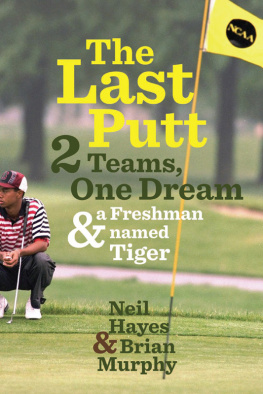Copyright 2010 by Neil Hayes and Brian Murphy
ALL RIGHTS RESERVED
For information about permission to reproduce selections from this book, write to Permissions, Houghton Mifflin Harcourt Publishing Company, 215 Park Avenue South, New York, New York 10003.
www.hmhco.com
The Library of Congress has cataloged the print edition as follows:
Hayes, Neil, date.
The last putt : two teams, one dream, and a freshman named Tiger / Neil Hayes and Brian Murphy.
p. cm.
ISBN 978-0-618-84004-5
1. Golf. 2. College sportsUnited States. 3. Oklahoma State UniversityGolf. 4. Stanford UniversityGolf. 5. Woods, Tiger. I. Murphy, Brian. II. Title.
GV 965. H 34 2010
796.352092dc22 2009035211
e ISBN 978-0-547-48711-3
v2.0614
To Marlys Gee for her counsel. For Charlee, Nick, and Riley, as always. Most of all, to Dad.
N. H.
For my Mom and Dad, and for Candace and Declan... for inspirations past, present, and future.
B. M.
Prologue
Scarlet Course, Ohio State University
Columbus, Ohio
May 31, 1995
CAR DOORS SLAMMED , golf spikes crunched, and heads turned as he walked onto the driving range on a late-spring morning at the Scarlet Course on the campus of Ohio State University. The dew had yet to evaporate, the sun barely peeking over the midwestern horizon, but already there was heat in the air.
He was skinny, only 160 pounds at six feet, and a bit gawky, but everyone looked. How could they not? Freshman or not, Tiger Woods had arrived at the NCAA Championships.
Just one month earlier, Tiger Woods had dominated the headlines at Augusta National, making the cut at the Masters in his first appearance at a major championship. As the winner of four consecutive USGA championships, he was a history maker. As the multiethnic star in an overwhelmingly white sport, he was a media fascination, with Sports Illustrated, the New York Times, and Golf Digest all clamoring for his time. To have Tiger Woods playing in the NCAA Championships was the modern equivalent of LeBron James or Kobe Bryant playing in college basketballs Final Four.
The Scarlet Course was the college playground of Buckeye legend Jack Nicklaus, the greatest player ever, but the presence of golfs celebrated new prodigy gave this years NCAA Championships an unprecedented visibility. This was clearly Tigers lair. The ESPN cameras proved it. The rookie arrived with his Stanford teammates, wearing Cardinal red, and with the most hype of any college player ever. By extension, that made the 1995 NCAAs the most-hyped team championship ever.
The Cardinal were defending national champions, intent on becoming the first college team in a decade to repeat. They were rock stars in an otherwise understated sport.
The Cardinal arrived in Ohio from the elite grounds of Stanford University in the progressive Bay Area, from one of the nations most academically exclusive campuses. Their avuncular coach, Wally Goodwin, who had rebuilt this sleeping giant into maybe the most celebrated college golf team in history, led them. They were anchored by seniors Notah Begay III and Casey Martin, the core of a team who had shocked the college golf world a year earlier with an NCAA championshipbest friends and kindred spirits.
Begay, who spent part of his childhood on a reservation in New Mexico, was already the best full-blooded Native American golfer in NCAA history. Martin, who grew up in rainy Oregon, was noticeable because of a rare circulatory disorder that made it difficult for him to walklet alone be part of a national championship team.
Stanford had the buzz and the story lines. The Cardinal had the title, Tiger, and every reason to believe their destiny was another championship.
But they also had an adversary.
As Stanford arrived that day in Columbus for the first round, another team warmed up on the practice range, proudly flying the black and orange of their school, unintimidated by the Cardinal mystique. The Oklahoma State Cowboys were a year removed from watching Stanford steal the 1994 NCAA championship the Cowboys thought was rightfully theirs. They took it hard. Slowly, that bitter disappointment was replaced by a newfound resolve. Everything they had done since then, every early-morning workout, every practice shot, every round, was aimed at one goal: restoring Oklahoma States tradition by winning the NCAA championship.
Oklahoma State leapfrogged Stanford on its way to Golf Worlds number-one team ranking heading into Columbus. It was where the Cowboys expected to be. Theyd won six national championships in twenty-one years under legendary coach Mike Holder and led the nation in top ten, top three, and top two finishes at the NCAA Championships as well. Despite the cow-town reputation and severe weather of the Stillwater campus, Holder had transformed it into a place known for its unyielding standards of golf excellence.
Stanford, which held the number-one spot for the first part of the season and had been described as perhaps the greatest collection of collegiate golf talent ever assembled, was now number two. More important, the final ranking would be determined during the next four tension-filled days in Columbus.
This championship was personal for seniors and best friends Alan Bratton and Chris Tidland, who were in danger of forever becoming known as members of the first class under Holder to graduate without winning a team championship. This was personal for junior Trip Kuehne, the cant-miss Golden Boy who looked at Tiger Woods that morning on the driving range differently from any other player at the Scarlet Course. They had a history, these two.
But the NCAA Championships were far from an individual showdown.
Scoring in college golf is dependent on five players, not one. A team sends its five best onto the course, and upon completion, the four best scores are counted in an aggregate total. The best four-day aggregate score would win the 1995 NCAA championship. This scoring system remained virtually unchanged until 2009, when the NCAA instituted a match-play format. In this system, the top eight teams qualify for head-to-head matches. In 1995, however, it was aggregate stroke play. Every member of the Stanford and Oklahoma State teams arriving in Columbus carried the burden of playing not just for himself but for his teammates as well.
Only in college golf do teammates spend years sacrificing for a common goal while creating bonds that last a lifetime. Maybe thats why Arnold Palmer once said his failure to win the NCAA tournament, when he was at Wake Forest, was one of the biggest disappointments of his career.
The NCAA Championships had a rich history. Name a great individual player from the last fifty yearsPalmer, Nicklaus, Watson, Mickelsonand he played in the NCAAs. The tournaments legacy reaches back even farther than that, to 1897, when Yale won the first team championship, beginning a string of Ivy League dominance that lasted until the 1930s. But college golf was different then. Back then, college players mostly remained amateurs after graduation, true to the gentlemans code of the game, a code that frowned on playing golf for money.
Then, the sport evolved. The PGA Tour took off in the 1950s and 1960s, and soon the best training ground for the big-money tour was college golf. From the great Wake Forest and Texas teams of the 1970s, with Curtis Strange and Jay Haas, Ben Crenshaw and Tom Kite, all the way to Phil Mickelsons Arizona State teams of the early 1990s, the NCAA championship had become an almost mandatory, if sometimes overlooked, rite of passage for the greatest players.
In the last decade, college golf became deeper than ever. Dynasties like Dave Williamss Houston Cougarswho won sixteen national titles from 1956 to 1985were from another era. Even Oklahoma State, which replaced Houston as the dominant program in college golf, was struggling to keep up. Talent was everywhere. Texas remained a perennial power. So were the Arizona schools. Florida, too. Jim Brown, the twenty-second-year Ohio State coach, called the teams gathered at his schools golf course in 1995 the most competitive field Ive ever seen.
Next page








